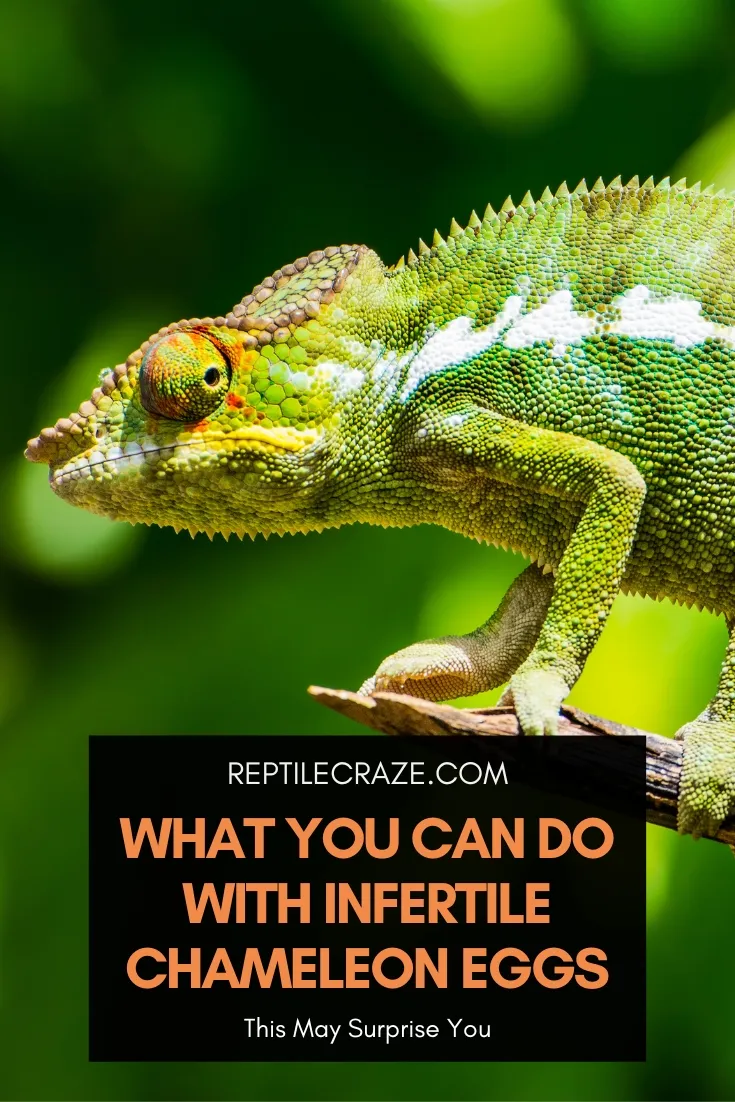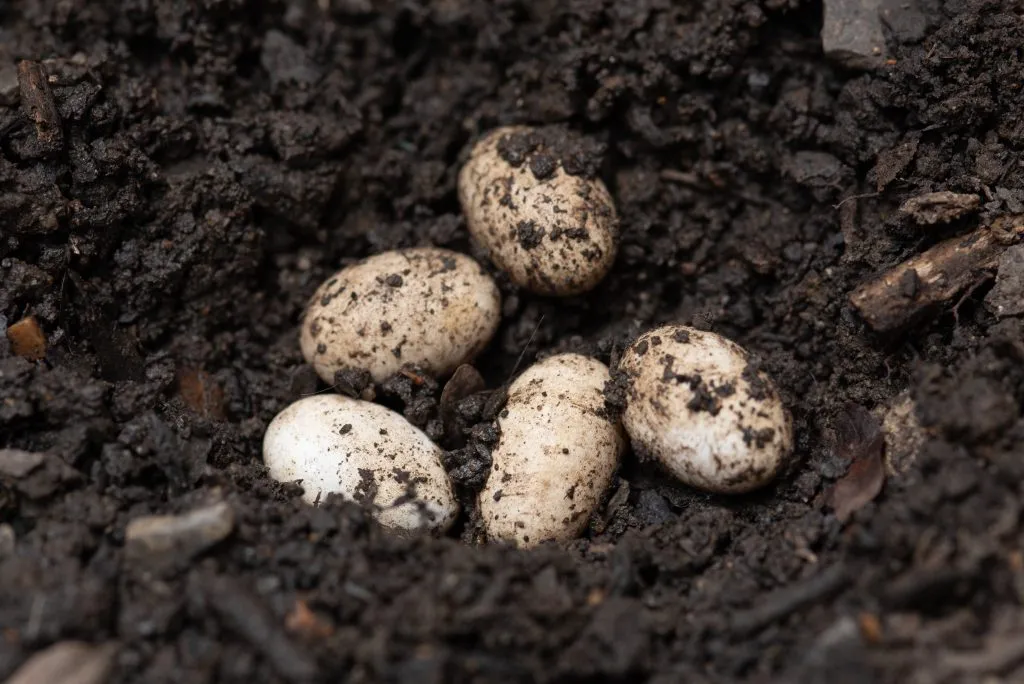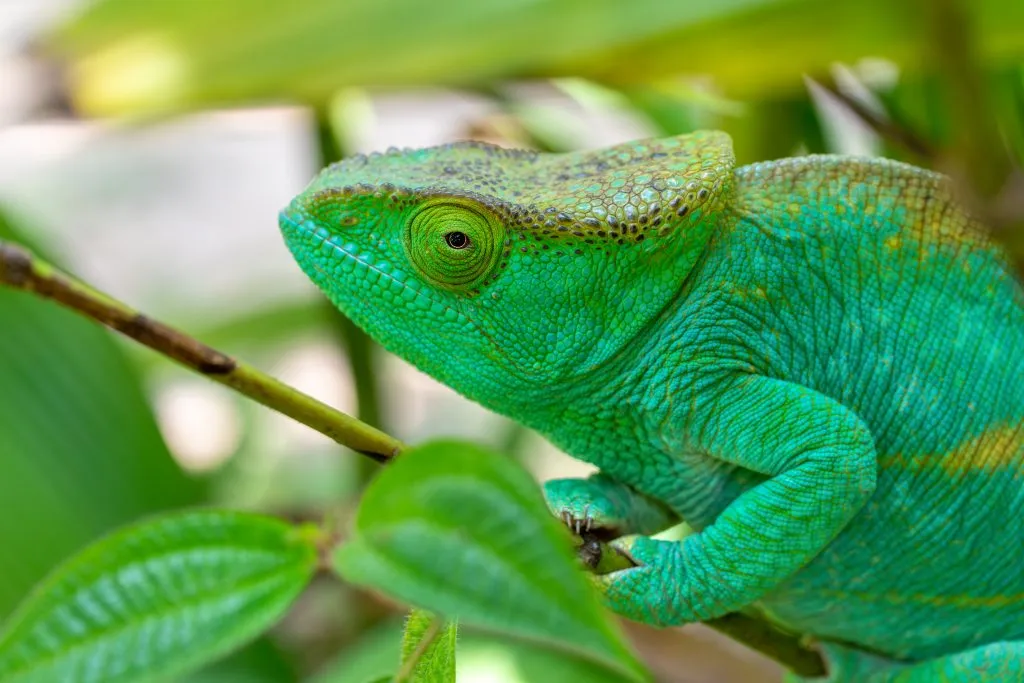
Chameleons often lay infertile eggs. On average, about 10% -15% of the total clutch or 2 to 3 eggs in 20 are infertile. Since no baby chameleons will ever possibly hatch from unfertilized eggs, you may want to repurpose them.
Treat infertile chameleon eggs much like infertile chicken eggs. You can cook and eat them, use them in art projects, donate them for educational purposes, supplement other pets’
Knowing how to distinguish between fertile and infertile eggs can help chameleon owners avoid wasting time waiting and speculating during lengthy hatch times. This article discusses why some eggs are not viable, how to recognize infertile eggs, and what to do with them.
Table of Contents
7 Things You Can Do With Infertile Chameleon Eggs
As long as you are certain that your chameleon eggs are infertile, you can use them just like any other unfertilized bird egg.
1. Cook and Eat Them
Infertile chameleon eggs consist of only the yolk and whites – like supermarket eggs – so you can treat yourself to tiny hard boiled eggs! Seriously, you can!
They are safe, nutritious, and even considered delicacies in some countries.
They can be boiled, fried in olive oil, and even scrambled. How about pickling them in a jar as you would quail eggs?
2. Feed Them To Other Reptile Pets
If you balk at the very thought of eating lizard eggs, you can feed them to other pet reptiles.
Your frilled dragons would love these nourishing delicacies! Just like this one chowing down on veiled chameleon eggs.
3. Supplement Cat or Dog Food
Unfertilized chameleon eggs are nutritious for your cats and dogs as well.
Mix these, raw or cooked, into your dog’s and cat’s
4. Help Enrich Composts and Control Garden Pests
Put those eggshells to good use in your garden.
Adding chameleon eggshells to your compost pile can help add calcium to your soil, a necessary nutrient for plant growth.
Eggshells may also repel pests such as slugs, snails, and cutworms. Crush and distribute them throughout the affected areas of your garden. The shells cut into the pests’ bodies, dehydrating and eliminating them.
You can create a healthier, more vibrant garden by incorporating infertile chameleon eggshells with those of others into your gardening routine.
5. Collect Them For Use In Crafts And Room Decor
These tiny eggs make interesting decorative elements you can display in jars and little bowls.
Dye them in vibrant hues, pastels, or neutrals to match the color theme of whatever art projects you may have.
You may have to blow out the eggs very carefully to avoid damage and create lasting ornaments.
6. Donate Them for Educational and Research Purposes

Chameleon eggs aren’t common, so they have great educational value.
Consider donating your infertile chameleon eggs to a local elementary, a reptile rescue, or a zoo.
You can also donate them to a laboratory that may need them as research material.
7. Discard Them
Finally, if you have no use for a tiny batch of infertile chameleon eggs, throw them away.
These eggs will rot and mold without preservation if left for over a week or more.
You’re bound to have more, anyway. Expect your chameleon to lay more infertile eggs again pretty soon.
Why Do Chameleons Lay Unfertilized Eggs?
Most female chameleons are oviparous. They lay eggs that could develop embryos and hatch outside their bodies.
The exception is Jackson’s chameleon which gives birth to live young!
New chameleon keepers are often surprised to find eggs lain by their females even without a mate! Female chameleons do not need a male to produce eggs.
Just like oviparous hens, chameleons will lay eggs whether fertilized or not. So, expect your females to lay eggs without mating with a male.
Can Chameleons Lay Infertile Eggs Even After Mating?
Even when mating has occurred, chameleons can still lay a clutch consisting of fertile and infertile eggs. As mentioned, you may expect between 10% and 15% of the eggs lain as nonproductive.
If you find an exceptionally high number of infertile eggs from your mated chameleon, consider looking into these factors:
- Age – too young or old
- Unhealthy – poor diet, environmental stressors
- Natural failure to fertilize
- Unsuitable breeding conditions
Are Fertile Eggs Possible Without Mating?

Female chameleons can’t reproduce without a male, so it is impossible for female chameleons to lay fertile eggs without the male’s sperm to fertilize them.
Fertile vs. Infertile Chameleon Eggs: How to Tell?
A fertile egg has the potential to hatch a baby chameleon. An infertile one will never hatch because there is no existing embryo inside.
The easiest way to recognize a fertile egg from an infertile one is by color and feel. Most fertilized chameleon eggs are chalky white and calcified (hard to the touch). Infertile eggs have yellowish shells that can feel squishy.
Although, many instances exist in which infertile eggs can look and feel as calcified as fertile ones.
If you need more clarification, it is best to wait before tossing them and to incubate these with the viable eggs until they develop tell-tale molds. Listen to this short advice below:
After 1-2 weeks, most infertile eggs begin to exhibit mold. Apparently, “live” eggs have some defense against molds, so you will always find them mold-free. But the minute the embryo in a fertile egg dies, the dead egg collapses and gets moldy.
You may use candling to determine whether a chameleon egg is fertile. Candling involves shining an intense light through an egg in the dark to see what’s inside. Infertile eggs will be visibly clear, while fertile eggs will have evidence of growth.
- Enchi Ball Python: A Unique and Stunning Morph of Python regius - March 27, 2025
- Emerald Tree Monitor: The Enigmatic Green Guardian of the Rainforest - March 26, 2025
- The Egyptian Cobra (Naja haje): A Fascinating Serpent - March 25, 2025
